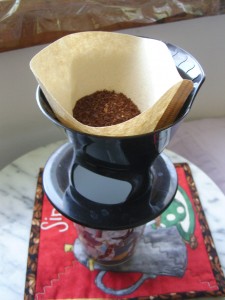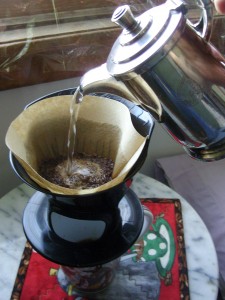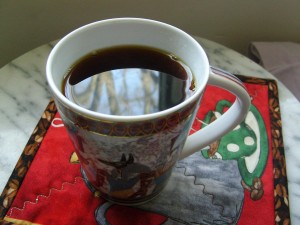I’ve become a coffee drinker only in, oh, the past month or two. Why now? Well, my former-barista boyfriend has probably had some influence over me. Not that he’s a coffee-pusher, but seeing him drink coffee frequently has, I’m sure, had a subconscious effect. Oddly enough, when I first met him and he was working as a barista, I never asked him to make me coffee. Green tea lattes all the way! He’s working in a different field now, but still drinks coffee. And slowly, my own caffeine habits have gone from drinking tea and the occasional half-caff cup of coffee to making my own fully caffeinated coffee at home, and ordering lattes when out. I still love all sorts of teas, but I’m pretty excited about coffee these days.
I thought for a while about how I wanted to make coffee at home. I’ve used a French press before, and hate cleaning them. Plus, I never (yet!) drink more than one cup at a time. During a discussion at work, my boss suggested making pour-over coffee. All you need is a little plastic doohickey. You can make one cup at a time. That thought stayed in my mind for a while, and one day I picked one up. Wow! I love it! The simplicity is genius. I don’t know why I didn’t realize that all the modern-day coffee gadgetry we use is, well, not the only option. I am always interested in learning the simpler, more hands-on way of doing something, especially in the kitchen. I will use my stand mixer to knead bread dough when I don’t feel like kneading it by hand. But there’s something I love about doing it by hand, when I have the time. So it is with coffee. When I make coffee using a French press or an electric coffee maker, I don’t feel involved in the process. Pouring water directly over the grounds and watching it drip through? Awesome.
As I started doing this at home and found myself needing to learn more about the technique, I read some stuff on the internet. Including a rather critical article, The Scourge Of Pour-Over Coffee, which calls the technique “a gastronomical ascot whose chief benefit seems to be that it roughly triples the time it takes to make a cup of coffee and allows consumers to then imagine that they can taste a difference.” Yet the author goes on to admit that it does taste different. His main quibble seems to be that it takes up unnecessary time when you go out to buy a cup of coffee in a bustling city. Sure, it does. I ordered my first cup of professionally-made pour-over coffee recently. I had to wait. But I expected that. In my mind, it’s the difference between getting take-out and going to a sit-down meal. Both are valid choices, and you should have different expectations for the two. If you’re going to pay someone (and yes, the pour-over coffee I bought cost more) to go through this by-hand process, you should expect to wait, and not see that as a burden. In my opinion.
And do I think there’s a difference in flavor? Maybe. I’m too new to coffee to be sure. I do know that the pour-over coffee I’ve had, both at home and out, is the only coffee I’ve ever had that I’m willing to drink black. Maybe that’s because it’s good coffee; maybe it’s the preparation method. What I know is that I like it, and that it’s the perfect method for my one-cup-at-a-time habit and enjoyment of doing things by hand.
For instructions, I recommend Googling something like “pour-over coffee method”. I’m still too experimental with my own methods to lay down a recommendation for you. What I will say is that you’ll see a variety of level of detail and precision in the instructions you find. You can get way into this, and buy a special ($30+) pouring kettle that will make a very fine stream of water that you can pour very accurately…I found that the spout on my little coffee pot (pictured below) works well enough for me. You can use a kitchen scale, if you want, to make sure the ratio of coffee grounds to water is spot-on. I did this once. Not sure that I care enough to do it every time. In other words, don’t get intimidated by the level of science and art that some people take this to. If you want to get into all of that, awesome. If not, you can still make a tasty cup of coffee. Like the one I’m drinking right now…photographed for you right here.




Lucy! I love your blog posts!!! And I’m thrilled to see your coffee mug mat!
Thank you!! I am thrilled to have such a lovely coffee mug mat! 🙂
My parents only ever made pour-over coffee, so that’s how I started drinking it, too! I mostly use my French press these days (and mostly to make cold-brew coffee for the week), but I agree that pour-over is the perfect method for a single cup!
And my mom also tells me that’s how her mother always made it! Using a French press for a do-ahead large batch makes total sense. Right now I have the luxury of long mornings (working later in the day), but someday, I bet I’ll want to make my coffee ahead of time.
Loved this blog. You make it very appealing. I LOVE my 2 cup Farberware percolator and it’s “instant” readiness, and delicious coffee., and it’s ALWAYS piping HOT.. But the “poured over” variety is worth a try!
Thank you! 🙂 Piping hot is nice. That’s one of the disadvantages of the pour-over method, at least with the brewer I have – it has vents on the side, which is nice because you can see the coffee going in and make sure it doesn’t overflow…but it also lets it cool down some. I’m not sure how the people who take 4-5 minutes with the pour-over method keep it hot (maybe it takes that long because they’re doing a larger batch? It only takes me a minute or two, and it still cools down a little bit.)
Oh my! You can tell it’s Wisconsin ’cause of the plastic over the window! I just looked at the photos again and realized that…
Yes! I actually took the plastic down just later that same day, because it’s been so ridiculously warm that I wanted to open the window overnight for sleeping comfort!